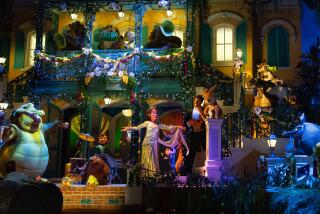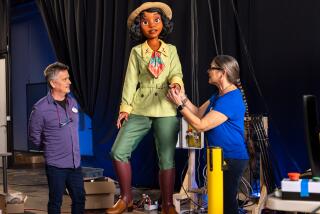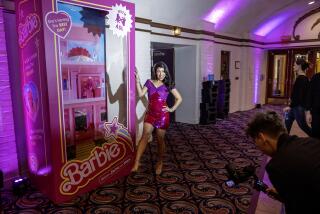Awakening a ‘Sleeping Beauty’
Walt Disney wanted his 1959 animation version of the fairy tale “Sleeping Beauty” to be the biggest and brightest full-length cartoon the studio had ever produced--a pretty tall order, considering the predecessors: “Snow White and the Seven Dwarfs,” “Dumbo,” “Pinocchio,” “Bambi” and “Fantasia.”
“There is no question he wanted ‘Sleeping Beauty’ to be what the French call ne plus ultra,” says Scott MacQueen, who restored “Sleeping Beauty” five years ago. “It was his biggest film--his most colorful. It was the most state-of-the-art presentation of animation that had ever been.”
More than six years in the making, “Sleeping Beauty” cost $6 million--at the time a record for an animated film. Produced on 70-millimeter film using three-strip Technicolor and a wide-screen process called Technirama, it also boasted a six-track stereophonic mix.
Featuring the music from Tchaikovsky’s “Sleeping Beauty Ballet,” the enchanting, sometimes scary fairy tale tells the story of Princess Aurora, cursed as a newborn by an evil witch named Maleficent. The evil fairy declares that before Aurora reaches her 16th birthday, she will die. To prevent her death, the three good fairies, Flora, Fauna and Merryweather, take Aurora to live in the country. But when she is 16, she is discovered by Maleficent and put to sleep. Only a kiss will awaken Aurora.
“Sleeping Beauty” has awakened in its original wide-screen splendor for a two-week engagement at the El Capitan Theatre in Hollywood that kicks off Thursday evening with a special making-of-the-movie panel discussion.
Mary Costa, the famed opera singer who provided the voice of Aurora, is scheduled to participate, as is legendary Disney animator Ollie Johnston, one of Disney’s “Nine Old Men,” who with Frank Thomas brought Flora, Fauna and Merryweather to delightful life. Rounding out the panel are MacQueen, animation critic Charles Solomon, musical historian Alex Rannie and current Disney animator Andreas Deja.
This fully restored wide-screen version of the film has been shown only once before in Los Angeles, says MacQueen. “It was at the wide-screen festival a few years back. The last time the El Cap ran the movie it was the 35-millimeter print, so the 7-millimeter hasn’t had big exposure here.”
Costa, now 72, is flying in from home in Knoxville, Tenn. She had done radio commercials and sang in her church choir in Glendale before landing the vocal role of Aurora. After the project, with Disney’s encouragement, she pursued her dream of becoming an opera singer.
All the talent involved in the film, she says, loved the project. “That comes out in the film, it truly does. I always say this was a once-upon-a-dream experience for me. It was the happiest time. It established so many things for me.”
Though they communicated only by phone during production, Disney became one of her biggest influences. He had chosen not to meet her because, she says, “he didn’t want to be influenced by my personality in person.”
Disney, Costa recalls, “would talk to me on the phone after the recording sessions and he would talk to me about what he expected. He said, ‘Don’t have anyone read a line for you. You must pull from your own gifts of colors.’ He believed everybody had a set of colors in their mind’s eye and that is part of their creative imagination. He didn’t believe that anybody should be a copy of another person.”
For insight into Aurora, Disney suggested she talk with artist Marc Davis, who was animating the character. “I asked him so many questions,” Costa says. “I watched him at his storyboards and one day, I wanted to make Marc Davis laugh. I thought it was a joke when I said, ‘Marc, what do you think the air was like back in the forest?’ He said immediately, ‘Caressing.’ It wasn’t a joke to him at all.”
Johnston says that originally Disney toyed with the idea that Flora, Fauna and Merryweather should all look the same. “He said, ‘We don’t need them to be all different,’ ” Johnston, 90, recalls. “But it would have lacked the entertainment.”
As with many of Disney’s animated films that featured human characters, a live-action version was filmed for the animators to use as models. Johnston says that he and Thomas also observed older women shopping in super markets in order to create the three fairies.
“We got to stare at old ladies and watched them to see how they behaved and whether they talked to each other,” Johnston recalls with a laugh. “We had fun with it.”
Just as with “Fantasia” in 1940, “Sleeping Beauty” wasn’t a huge hit when it was released, grossing just $5.3 million in its initial release and receiving mixed reviews from the critics, many of whom thought the film was too elaborate for such a simple story. Bosley Crowther of the New York Times even criticized the climactic battle sequence between Maleficent and Aurora’s intended, Prince Phillip, as too scary for children, describing the fight as “the noisiest and scariest go-around [Disney] has ever put into one of his films.” “I do think it was ahead of its time,” says Costa. “It was innovative, and the backgrounds were so exquisite. It is an art piece.”
MacQueen says when the film was released, movies were “getting a little bit tougher and more realistic. It had to compete in that market. There wasn’t quite the market for fairy tales at that time than there previously had been.”
“Sleeping Beauty” also had a distinctly different style than the previous animated features that many animation fans had a hard time warming up to. “It is like nothing they have done before or since,” says MacQueen. “People who are in love with the old style, that whole European fluid-color look of the early features, sometimes reject it because of its hard geometry and its bright color. But it uses that very graphic style brilliantly.”
The wide-screen format also allowed the filmmakers to experiment with visual composition “in ways that I don’t think have ever been matched in animation,” says MacQueen. “It uses the frame shape brilliantly.”
*
“Sleeping Beauty” screens Thursday at 7 p.m. and Friday through Sept. 8 at noon, 2:30, 5 and 7 p.m. Admission is $10 for adults, $6.50 for seniors, children and matinees, which are the first two shows of the day. To order tickets call (800) DISNEY6 or go to elcapitantickets.com
More to Read
Only good movies
Get the Indie Focus newsletter, Mark Olsen's weekly guide to the world of cinema.
You may occasionally receive promotional content from the Los Angeles Times.











